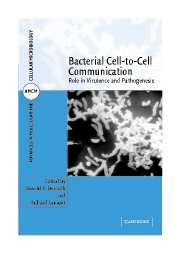Book contents
- Frontmatter
- Contents
- List of Contributors
- Preface
- 1 Quorum sensing and regulation of Pseudomonas aeruginosa infections
- 2 The Pseudomonas aeruginosa quinolone signal
- 3 Quorum-sensing-mediated regulation of plant–bacteria interactions and Agrobacterium tumefaciens virulence
- 4 Jamming bacterial communications: new strategies to combat bacterial infections and the development of biofilms
- 5 Quorum-sensing-mediated regulation of biofilm growth and virulence of Vibrio cholerae
- 6 LuxS in cellular metabolism and cell-to-cell signaling
- 7 LuxS-dependent regulation of Escherichia coli virulence
- 8 Quorum sensing and cell-to-cell communication in the dental biofilm
- 9 Quorum-sensing-dependent regulation of staphylococcal virulence and biofilm development
- 10 Cell-density-dependent regulation of streptococcal competence
- 11 Signaling by a cell-surface-associated signal during fruiting-body morphogenesis in Myxococcus xanthus
- Index
- Plate Section
- References
6 - LuxS in cellular metabolism and cell-to-cell signaling
Published online by Cambridge University Press: 08 August 2009
- Frontmatter
- Contents
- List of Contributors
- Preface
- 1 Quorum sensing and regulation of Pseudomonas aeruginosa infections
- 2 The Pseudomonas aeruginosa quinolone signal
- 3 Quorum-sensing-mediated regulation of plant–bacteria interactions and Agrobacterium tumefaciens virulence
- 4 Jamming bacterial communications: new strategies to combat bacterial infections and the development of biofilms
- 5 Quorum-sensing-mediated regulation of biofilm growth and virulence of Vibrio cholerae
- 6 LuxS in cellular metabolism and cell-to-cell signaling
- 7 LuxS-dependent regulation of Escherichia coli virulence
- 8 Quorum sensing and cell-to-cell communication in the dental biofilm
- 9 Quorum-sensing-dependent regulation of staphylococcal virulence and biofilm development
- 10 Cell-density-dependent regulation of streptococcal competence
- 11 Signaling by a cell-surface-associated signal during fruiting-body morphogenesis in Myxococcus xanthus
- Index
- Plate Section
- References
Summary
INTRODUCTION
Many bacteria regulate gene expression in a cell-density-dependent manner; this behaviour has been collectively referred to as quorum sensing or cell-to-cell communication. In its simplest form this process results from the production and accumulation of signaling molecules in the surrounding environment. At some threshold concentration, the signaling molecules (also referred to as autoinducers) bind to receptors on or in the bacterial cell that regulate gene expression. In recent years the significance of cell-to-cell signaling in bacteria has become widely appreciated and has been extensively reviewed (2, 21, 25, 64, 84, 106).
The concept that bacterial cells can communicate through small-molecule chemical signals first arose in the pioneering studies in the Hastings laboratory in the early 1970s. Vibrio fischeri produces light; the light production is induced as a culture reaches high cell density, i.e. in a cell-density-dependent manner. In the seminal paper by Nealson et al. (69) it was demonstrated that cell-free cultures of V. fischeri contained a substance (termed an autoinducer) which, when added back to cell cultures, induced light production in the cells at a much earlier stage in the culture. Since that time the field of cell-to-cell signaling (quorum sensing) has grown dramatically; in recent years there has been an explosion of research in this area. In general there remain two well-established paradigms of cell-to-cell signaling: the N-acyl homoserine lactones used by some Gram-negative bacteria (see Chapters 1 and 3) and the oligopeptide signals used by some Gram-positive bacteria (see Chapters 9 and 10).
- Type
- Chapter
- Information
- Bacterial Cell-to-Cell CommunicationRole in Virulence and Pathogenesis, pp. 117 - 150Publisher: Cambridge University PressPrint publication year: 2006
References
- 1
- Cited by



